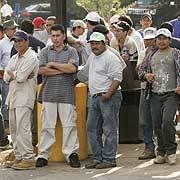Immigrants And Infrastructure
 Yesterday's NYTimes article on the immigration bill and the pro-immigration reform organization Numbers USA included this passage about the group:
Yesterday's NYTimes article on the immigration bill and the pro-immigration reform organization Numbers USA included this passage about the group:It's pretty much a bogus argument, or at the least, sensationalized. Only 5 or 6 percent of the United States landmass is developed, so urban sprawl is a chimera, a bogeyman that's waved at the public by anti-growth zealots. Besides, one man's sprawl is another's suburban dream.The organization wants to reduce immigration — as Mr. [Roy H.] Beck says in the subtitle of his book — for “moral, economic, social and environmental reasons.”
He contends that immigrants and their children are driving population growth, which he says is gobbling up open space, causing urban sprawl and creating more traffic congestion.
But that is not to say immigrants don't have a huge negative environmental impact on the American communities where they live, because they do -- and ironically, the reason why they're so disastrous environmentally is because they exemplify the hallowed Greenie ideal of high-density urban development.
I first became aware of this a few years back when a candle caught a curtain on fire at a house in Orange, CA. Fire fighters responded but had a heck of a time finding the fire -- because the house's owner had partitioned the 2,200 square foot home into a 17-bedroom tenement for immigrants.
The same is true throughout much of immigrant-haven Orange County, and in similar places around the country. Houses designed for a single family now are home to a dozen or more immigrants, from the garage to the attic, these houses are stacked full of dinky human habitats -- dinky by our scale, but not bad by their hometown standards.
But here's the problem: City infrastructure was sized in anticipation of four, five or six people living in that 2,200 square foot house, not 17.
Sewer pipes are sized for the smaller family's flushes; water supplies are predicated on having smaller families; roads and parking spaces anticipated fewer cars, and on and on: from the size of the neighborhood transformer to the regional power plant to the number of pews in the church and classrooms at the school -- all were planned for fewer people in each of the homes.
I doubt if the various estimates we've seen about the social costs of illegal immigration factor in the warp-speed deterioration of overtaxed infrastructure and the subsequent cost of replacing and up-sizing.
I also doubt if this info will turn any pro-immigration advocates into members of Numbers USA, but these economic arguments are more valid than the ones they're using.
Labels: Immigration




<< Home